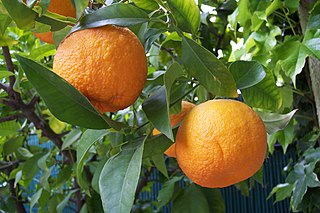
Bitter orange, sour orange, Seville orange, bigarade orange, or marmalade orange is in a narrow sense the citrus tree Citrus × aurantium and its fruit. It is native to Southeast Asia and has been spread by humans to many parts of the world. It is probably a cross between the pomelo, Citrus maxima, and the mandarin orange, Citrus reticulata.

A tunicate is an exclusively marine invertebrate animal, a member of the subphylum Tunicata. This grouping is part of the Chordata, a phylum which includes all animals with dorsal nerve cords and notochords. The subphylum was at one time called Urochordata, and the term urochordates is still sometimes used for these animals. They are the only chordates that have lost their myomeric segmentation, with the possible exception of the seriation of the gill slits. However, doliolids still display segmentation of the muscle bands.

The sea pineapple is an edible ascidian consumed primarily in Korea, where it is known as meongge (멍게), and to a lesser extent in Japan, where it is known as hoya (ホヤ) or maboya (マボヤ).
Citrus oxanthera, synonym Oxanthera aurantium, is a species of plant in the family Rutaceae. Sometimes referred to commonly as the orange-flowered oxanthera, it is endemic to New Caledonia.

Halocynthia is a genus of ascidian tunicates in the family Pyuridae. Species such as H. roretzi are eaten in parts of Asia as a delicacy.
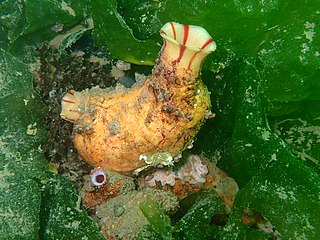
Pyuridae is a family of tunicates.
Haliotis pourtalesii aurantium is a subspecies of edible sea snail, a marine gastropod mollusk in the family Haliotidae, the abalones. This is a Western Atlantic species.

Halocyntia papillosa, also known as the red sea squirt is a sea peach or sea squirt, a species of tunicate.
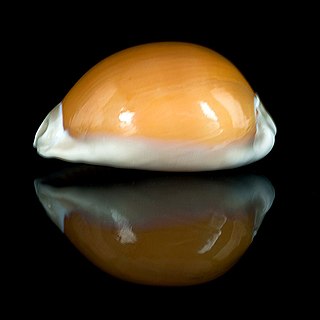
Callistocypraea aurantium, common name the golden cowrie, is a species of sea snail, a cowry, a marine gastropod mollusk in the family Cypraeidae, the cowries.

Lyncina is a genus of sea snails, marine gastropod molluscs in the family Cypraeidae, the cowries.
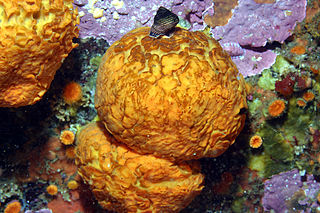
Tethya aurantium, also known as the golf ball sponge or orange puffball sponge, is a species of sea sponge belonging to the family Tethyidae. It is spherical in shape, with a warty surface, and grows to about 10 cm in diameter. Oscula are present on the upper surface. The surface has sharp protruding spicules which can cause skin irritation if touched.
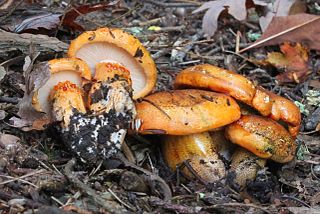
Tricholoma aurantium, commonly known as the golden orange tricholoma, is a mushroom of the agaric genus Tricholoma. Originally described by Jacob Christian Schäffer in 1774, it was transferred to the genus Tricholoma by Adalbert Ricken in 1915.

Halocidin is an antimicrobial peptide isolated from the Halocynthia aurantium species of tunicate. In mouse models, derivative peptides have shown efficacy in the treatment of fungicidal resistant Candida Albacans when used as a mouthwash additive.

Polyclinum aurantium is a species of colonial sea squirt, a tunicate in the family Polyclinidae. It is native to shallow water in the northeastern Atlantic Ocean and Mediterranean Sea.
Ascidiaceihabitans is a Gram-negative and aerobic genus of bacteria from the family of Rhodobacteraceae with one known species. Ascidiaceihabitans donghaensis has been isolated from the sea squirt Halocynthia aurantium from the Sea of Japan in Korea.
Litoreibacter ascidiaceicola is a Gram-negative, aerobic and non-motile bacterium from the genus of Litoreibacter which has been isolated from the sea squirt Halocynthia aurantium from Namhae in Korea.
Litoreibacter meonggei is a Gram-negative and non-motile bacterium from the genus of Litoreibacter which has been isolated from the sea squirt Halocynthia roretzi from the South Sea in Korea.
Tenacibaculum ascidiaceicola is a Gram-negative and non-spore-forming bacterium from the genus of Tenacibaculum which has been isolated from the sea squirt Halocynthia aurantium.
Paraglaciecola mesophila is a Gram-negative, slightly halophilic, heterotrophic and motile bacterium from the genus of Paraglaciecola which has been isolated from the liquor of an ascidian from the Troista Bay in Russia.

Halocynthia igaboja, commonly known as sea hedgehog, bristly tunicate or spiny sea squirt, is a species of tunicate in the family Pyuridae. It is native to the northeastern Pacific Ocean. This species was first described in 1906 by the Japanese marine biologist Asajiro Oka, who gave it the name Cynthia ritteri. It was later transferred to the genus Halocynthia.













